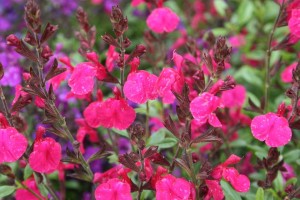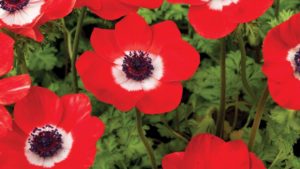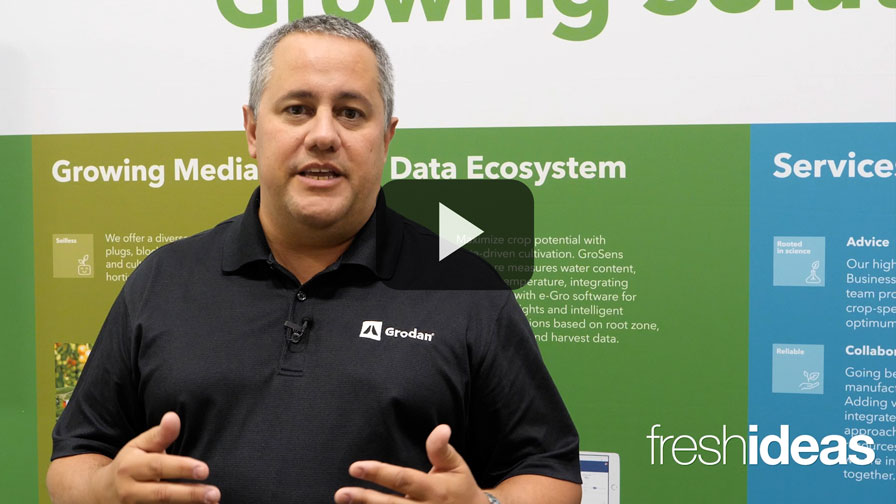Tender Perennials Can Create Marketing Challenges

Darwin Perennials introduced the Mirage salvia series this year, which flowers continuously throughout the summer in the North.
As plant breeding breeding pushes boundaries, perennial producers continue to break with tradition. The botanical term commonly tossed around to demarcate perennials from their shorter-lived annual cousins has become difficult to pin down, at least in a marketing sense, as breeders offer more tender perennials to growers. Even more perplexing for growers — determining how to use these plants and where they profitably fit in their product mix.
What’s In A Name?
The term “tender perennial” or “temperennial” refers to plants that are perennial in tropical climates but grown as annuals in colder climates. Unfortunately, it can be misleading. The confusion relates to plant hardiness, generally associated with temperature, but which also encompasses weather extremes, soil types, and in some cases biology, says Jared Barnes, Assistant Professor of Horticulture at Stephen F. Austin University in Nacogdoches, TX.
”Rising temperatures and shifting precipitation patterns caused by global warming play a role, too,” Barnes says. ”In short, as you go further north, gardeners will likely see tender perennials come back more often. As a result, they may begin to appear more often in landscapes and garden centers.”
First-year flowering perennials that don’t require vernalization also cause misunderstandings about tender perennials because growers can grow them more like annuals and oftentimes with the same scheduling. Cosmos atrosanguineus ‘Black Magic’ from Jelitto falls in this category. With hardiness in Zones 9 to 12, most growers will treat it as an annual.
Tender Perennials Don’t Slot Easily Into A Single Category
The confusion over what a tender perennial is or isn’t makes it difficult for growers to place them in their product lineup.
“Perennials growers don’t want to grow them because they are not hardy for all the main regions of what is considered hardy perennials. Annual growers don’t want them because they’re not familiar with them, and they don’t have the experience for these crops,” says Zoltan Kovacs, Perennial Product Manager at Dümmen Orange. “They often fall in the pot plant category because growers have no place for them in other programs because these plants belong in the annual and perennial category as well, so they don’t really belong to any program.”
Dümmen Orange focuses on perennials that are hardy for all regions, but it does have a few tender perennials this year, such as its Penstemon hartwegii Peptalk Series and Stachys byzantina ‘Belle Grigio.’ Both are hardy in Zone 7.
While many growers prefer to focus on hardy perennials, Mark Huber, Territory Manager for The Perennial Farm in Glen Arm, MD, says there is a certain demand for tender perennials that can’t be ignored. He adds that The Perennial Farm has sold out of tropical items for the year and is seeing success with non-hardy succulents, both of which fall into the tender perennial category.
Breeders like Darwin Perennials also see the value in bringing tender perennials to market. The company delved into the category after a request from its Southern customers to do more work in the Zone 7 category, says Global Products Manager Karl Batschke.
“We realized we were missing a whole group of plants that were perennials in the South, but annuals in the North because of our fairly rigid definition of what a perennial is, based on Northern hardiness,” he says.
Darwin first introduced Foxlight digitalis, which overwinters in Zone 7b conditions. This year, the company brought out the Mirage Salvia Series. Both plants flower continuously throughout the summer in the North.
“We want to offer growers more diversity and address some of their constraints by having a high-value product they can put into the market early or later,” Batschke says.
Walters Gardens is also bringing out more temperennials, like the new Mad About Mangave collection. Mangave is a relatively new hybrid cross between Manfreda and Agave. Also new is Cordyline terminalis ‘Cherry Cordial,’ a sport of ‘Chocolate Queen’ with vibrant red coloration.

The Harmony Anemone Series (Sakata Ornamentals) has great seed availability. Growers can use it as a cool-season annual, or for their perennial programs if they are in warmer regions.
Growers Must Communicate What To Expect From Tender Perennials
Tender perennials’ biggest advantage is the flexibility they offer so growers can take advantage of early and late shoulder seasons. And they offer unique selections for decorative containers, particularly for Northern growers. One of these selections is Sakata Ornamentals’ new Harmony Anemone series. The series is Zone 7 hardy, so it can be grown with other cool-crop annuals or used for perennial programs in warmer regions.
Greg Soles, Product Representative for Darwin Perennials, says tag and point-of-purchase information is critical to defining the boundaries of a plant, and growers must clearly communicate to customers exactly what they can expect from tender perennials. Equally as important is communicating their value, because they are likely to have a higher price point than annuals.
“When you pay a lot for a perennial, even if you know it is going to die, you want to get your money’s worth by their strong performance,” says Richard Hawke, Plant Evaluation Manager for the Chicago Botanic Garden.
It isn’t too far-fetched to believe that tender perennials have the potential to sell well, Kovacs says, citing the example of consumers annually buying poinsettias and mums that they know will die.
“If someone can convince consumers of the value of these plants, it doesn’t matter if it is an annual or a perennial,” he says. “The sales will be there. Because of the added value for this interesting and exciting plant category.”
Customers Have The Ultimate Say
Still, growers might find tender perennials a hard sell to the masses. However, with good marketing and education to raise consumer awareness of their value, the hope is consumers will recognize the diversity of the product that is available to them and how tender perennials can help extend the season, says Batschke.
In the end, Kovacs recommends letting the consumer decide, saying, “I would tell growers to be open-minded. Forget that a plant is an annual or a perennial and look at what you are missing, what season you can add on, and what fits with your production schedule. Let the consumer decide if there’s a market for them or not.”
In order to increase sales of tender perennials for the future, we need to come up with new and creative programs where we can fit this category of plants, to add something new and exciting with added value to our everyday offerings.

The field trial gardens at the Chicago Botanic Gardens.
Evaluating Tender Salvias For Commercial Potential
Richard Hawke, Plant Evaluation Manager for the Chicago Botanic Garden, is making his first foray into treating a perennial like an annual. For the next three years, he will evaluate 108 cultivars of tender salvia for their performance and commercial potential in Northern markets.
Hawke will not overwinter the salvias by digging them up. Instead, he will replant salvias that do not survive the Chicago winter from stock plants in June. If any do make it through the winter, he plans to evaluate them as true perennials.
“Ultimately, we’re looking to see how these plants come through the winter,” Hawke says. “Also, to evaluate their behavior and characteristics to see if they are worth consumers spending their money on because they perform well.”
Watch for the results from Hawke’s salvia trials on ChicagoBotanic.org.









